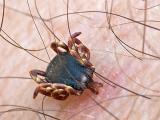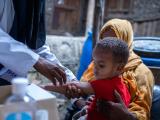Apr 11, 2003 (CIDRAP News) The head of the World Health Organization's (WHO's) communicable disease programs says severe acute respiratory syndrome (SARS) may pose a more serious global health threat than any other new disease in the past 20-plus years, with the sole exception of AIDS.
"If the SARS virus maintains its present pathogenicity and transmissibility, SARS could become the first severe new disease of the 21st century with global epidemic potential," Dr. David L. Heymann said in a report issued today.
"With the notable exception of AIDS, most new diseases that emerged in the last two decades of the previous century or established endemicity in new geographical areas have features that limit their capacity to pose a major threat to international public health," he wrote.
For example, pathogens such as Nipah virus, Hendra virus, and hantavirus never established efficient human-to-human transmission, while Escherichia coli O157:H7 and variant Creutzfeldt-Jakob disease depend on food as a transmission vehicle, Heymann wrote. He also described factors that limit either the widespread transmission or the virulence of several other diseases, including West Nile fever and viral hemorrhagic fevers.
"In contrast, SARS is emerging in ways that suggest great potential for rapid international spread under the favourable conditions created by a highly mobile, closely interconnected world," Heymann stated. The illness has an apparent incubation period of 2 to 10 days, long enough to permit asymptomatic carriers to travel "from one city in the world to any other city having an international airport." Further, respiratory secretions can spread the pathogen, and the initial symptoms are nonspecific and common, he said.
"The concentration of cases in previously healthy hospital staff and the proportion of patients requiring intensive care are particularly alarming," Heymann added.
WHO reported today a cumulative global total of 2,781 cases of SARS, an increase of 59 since yesterday, with 111 deaths. Slightly fewer than half of all patients1,337have recovered. In the United States, the Centers for Disease Control and Prevention (CDC) was reporting 166 suspected cases in 30 states as of yesterday.
In Heymann's report and at a press briefing today, WHO officials said that while SARS has spread to 17 countries, it has not spread inside most of those countries. "Seventeen countries are now affected by the outbreak, but it is important to note that only in four of these is there local transmission documented," said Dr. Mike Ryan at the news briefing, a transcript of which was posted on the WHO Web site.
Ryan later commented, "We may see further countries affected by SARS. . . . The question is: are countries in a position to rapidly isolate imported cases and ensure that there's no local transmission in their communities? Right now countries are being successful in doing that. We're not seeing the amplifications that we were seeing three weeks ago in this outbreak."
Concern about possible local transmission in the United States increased yesterday with the report that a woman in the Gainesville, Fla., area appeared to have contracted SARS at work. The Associated Press reported that a 47-year-old woman was believed to have been infected by a 60-year-old female co-worker who had been in Asia. All previous US patients have been people who traveled to affected parts of Asia or were in close contact with other SARS patients who traveled to those areas.
At a news briefing yesterday, CDC Director Dr. Julie Gerberding said the woman who had traveled had gone to work in the early stage of the illness and that Florida health officials identified a coworker with a respiratory illness. "So that worker is now on the list of suspected SARS patients, but it's far too early to indicate whether any of these individuals actually has SARS," Gerberding said.
She said CDC would work with state health departments to step up active monitoring of contacts of SARS patients in the hope of preventing community transmission. Also, CDC yesterday issued guidelines for management of school children exposed to the illness.
In other developments, Indonesia and the Philippines reported their first SARS cases, according to an AP report today. Both patients were foreigners who had traveled to Hong Kong or Singapore, the report said. At this writing, the two countries were not yet on the WHO list of nations affected by the epidemic.
In Hong Kong, the city hardest hit by SARS, health officials today reported 61 cases of SARS, for a cumulative total of 1,059 cases, with 32deaths. The city has ordered about 200 members of households with known SARS patients to stay home for 10 days, the AP reported.
Eleven of the new patients in Hong Kong are residents of Amoy Gardens, a large apartment complex where many people have fallen ill. The outbreak there has prompted intense investigation of the possibility that the disease can spread via environmental factors, not just close personal contact.
At the WHO briefing, Heymann said Hong Kong investigators have ruled out cockroaches and cats as SARS virus vehicles. "Pieces of the genetic material of the coronavirus [believed to be the cause of SARS] have been found in feces of some persons who are infected or who have the disease," he said. "It's not yet known whether there are just pieces or fragments of the virus or the whole virus which is infective."
See also:
Dr David Heymann's SARS status report
http://www.who.int/csr/sarsarchive/2003_04_11/en/
Transcript of Apr 11 WHO news briefing
http://www.who.int/csr/sars/Press_2003_04_11/en/
Transcript of CDC's Apr 10 news conference
http://www.cdc.gov/media/transcripts/t030410.htm
CIDRAP News story on SARS guidelines in schools


















